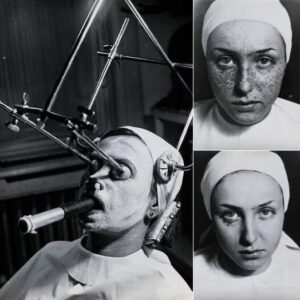Seventeen-year-old Michael Dumas never imagined that a sunny day on the beach would change his life for months to come.
What began as a fun afternoon with friends on a missionary trip to Florida soon spiraled into a painful medical ordeal that shocked both his family and doctors.Family games
In mid-June, Michael joined 17 boys from his church youth group on a mission trip to Pompano Beach, Florida.
The group spent their free day enjoying the ocean — swimming, building sandcastles, and even burying one another in the soft, warm sand. It was a classic summer scene filled with laughter and sunshine.
But hidden beneath that sand was an invisible danger: hookworm larvae — microscopic parasites capable of penetrating human skin.
After returning home to Memphis, Tennessee, Michael initially complained of what seemed like a simple earache.
Within days, however, itchy red bumps began appearing on his feet. More lesions soon developed on other parts of his body, growing increasingly painful and inflamed.
Alarmed, his mother Kelli Mulhollen Dumas took him to their family pediatrician.
The diagnosis was shocking: cutaneous hookworm infection, caused by parasitic worms that had burrowed into his skin.
A Mother’s Horror
Kelli, who is both a dentist and has a degree in biology, found the news deeply disturbing despite her scientific background.
“I’m a dentist, and I have a degree in biology — I’ve dissected things. Science is my gig,” she said.“But hearing that your son has parasitic worms living under his skin, moving and growing, was unbearable.
My stomach turned into a tight knot. I thought I was going to throw up.”
Doctors found multiple hookworms living beneath Michael’s skin, including one that measured three inches long.
The idea that such organisms were literally moving within her child horrified Kelli:
“I just kept picturing those worms making babies inside my baby’s body,” she said.
How It Happened: Understanding Hookworm Infections
According to the Centers for Disease Control and Prevention (CDC), hookworms are parasitic worms whose larvae can infect humans by penetrating intact skin.
The infection typically occurs in tropical or subtropical environments, particularly where animal feces contaminate soil or sand.
The larvae hatch from eggs left in the environment by infected animals — often dogs or cats. In warm, moist sand, the larvae can survive for several weeks.
When a person walks barefoot, lies, or plays on contaminated ground, the microscopic larvae can burrow directly through the skin.
In Michael’s case, he later recalled being buried in the sand by friends as part of a playful game — a moment his mother now believes was the source of the infection.
More Than One Victim
Michael’s case was not isolated. In the days following the trip, at least five other members of the same missionary group tested positive for hookworms.
This cluster of infections highlighted how easily the parasite can spread through contaminated sand and how unaware many people are of the risk.
Symptoms and Complications
Michael developed painful, serpiginous (“snake-like”) red lesions that tracked under his skin — a hallmark sign of cutaneous larva migrans.
The itching was severe, and some areas blistered. The infection became complicated by a secondary bacterial (staph) infection, which caused open wounds and delayed healing.
“My son has permanent scars,” Kelli said. “He had a gaping wound on his right foot that required four stitches. This isn’t just an insect bite — it’s a medical nightmare.”
Because of the infection and pain, Michael was unable to leave home for weeks. The family had to follow strict wound-care procedures to prevent further complications.Family games
Diagnosis and Medical Testing
Doctors usually diagnose hookworm infection based on clinical appearance and exposure history. Key signs include:
Itchy, raised, wavy (“snake-like”) skin tracks
Red or blistered papules
Burning or tingling along the lesion path
In Michael’s case, visual examination was enough to identify the cause. Blood tests may also show elevated eosinophil levels, indicating a parasitic infection.
Stool or skin tests can confirm the presence of larvae, although this is not always necessary in mild cases.
Treatment and Recovery
Michael underwent a combination of treatments, including:
Antiparasitic medication such as albendazole and ivermectin to kill the larvae.
Cryotherapy, a procedure where doctors froze sections of infected skin to destroy remaining parasites.
Antibiotics to fight the secondary bacterial infection.
Pain management and topical ointments to relieve itching and irritation.
Recovery took several weeks, but because the infection had penetrated deeply, some of the lesions left permanent scarring.
What to Watch For
If someone may have been exposed to contaminated soil or sand, watch for the following signs within a few days or weeks:
Itchy, raised red lines or tracks on the skin
Lesions that spread or move
Burning or tingling sensations
Signs of infection (swelling, pus, fever)
Medical attention should be sought immediately, as untreated infections can lead to secondary bacterial infections or, in rare cases, systemic complications such as anemia or gastrointestinal issues.
Prevention: How to Stay Safe
The CDC and public health experts recommend several steps to prevent hookworm infection:
Avoid walking barefoot on beaches or in areas where animals may defecate.
Do not bury yourself or others in sand, especially on public beaches where contamination is possible.
Clean up pet waste promptly and dispose of it properly.
Encourage good hygiene and sanitation in recreational areas.
Wash skin thoroughly after beach or soil exposure, especially if contact with sand was direct.
The Bigger Picture
Michael’s experience is a powerful reminder that even the most innocent beach traditions can carry hidden dangers.
Hookworm infections are largely preventable, but many people remain unaware that they can occur in the United States — particularly in warm, humid regions like Florida.
As Kelli reflected on the ordeal, she emphasized the importance of awareness and prevention:
“I never dreamed this could happen from playing in the sand,” she said. “People need to know that the risk is real — and that a little caution can save you from something truly horrible.”





